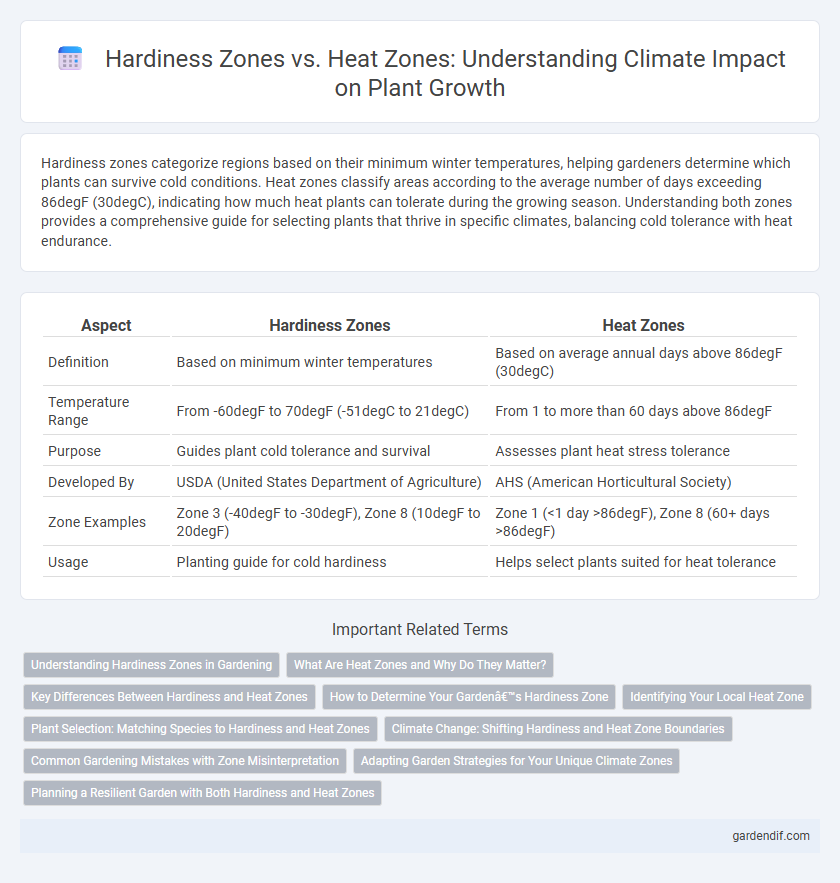
Hardiness zones vs Heat zones Illustration
Hardiness zones categorize regions based on their minimum winter temperatures, helping gardeners determine which plants can survive cold conditions. Heat zones classify areas according to the average number of days exceeding 86degF (30degC), indicating how much heat plants can tolerate during the growing season. Understanding both zones provides a comprehensive guide for selecting plants that thrive in specific climates, balancing cold tolerance with heat endurance.
Table of Comparison
| Aspect | Hardiness Zones | Heat Zones |
|---|---|---|
| Definition | Based on minimum winter temperatures | Based on average annual days above 86degF (30degC) |
| Temperature Range | From -60degF to 70degF (-51degC to 21degC) | From 1 to more than 60 days above 86degF |
| Purpose | Guides plant cold tolerance and survival | Assesses plant heat stress tolerance |
| Developed By | USDA (United States Department of Agriculture) | AHS (American Horticultural Society) |
| Zone Examples | Zone 3 (-40degF to -30degF), Zone 8 (10degF to 20degF) | Zone 1 (<1 day >86degF), Zone 8 (60+ days >86degF) |
| Usage | Planting guide for cold hardiness | Helps select plants suited for heat tolerance |
Understanding Hardiness Zones in Gardening
Hardiness zones categorize regions based on minimum winter temperatures, helping gardeners select plants that can survive cold conditions. These zones are defined by the USDA Plant Hardiness Zone Map, which divides areas into 13 zones with 10degF increments. Understanding hardiness zones ensures the selection of cold-tolerant plant species, reducing winter damage and increasing garden success.
What Are Heat Zones and Why Do They Matter?
Heat zones define regions by the average number of days temperatures exceed 86degF, a critical threshold where plant injury can occur, offering gardeners essential insight beyond traditional hardiness zones that only consider cold tolerance. Understanding heat zones helps in selecting plants that not only survive winter cold but also thrive during hot summers, ensuring better growth and productivity. This distinction is vital for landscaping and agricultural planning, especially as climate change increases heat stress worldwide.
Key Differences Between Hardiness and Heat Zones
Hardiness zones categorize regions based on minimum winter temperatures, guiding plant survival through cold tolerance, while heat zones assess the number of days with temperatures above 86degF, indicating plant heat stress. Hardiness zones, defined by the USDA, use a temperature scale from -60degF to 70degF, whereas heat zones, developed by the American Horticultural Society, count heat exposure days to evaluate plant resilience to heat. Understanding these zones helps gardeners select plants suited for both cold extremes and high-temperature conditions, ensuring optimal growth and survival.
How to Determine Your Garden’s Hardiness Zone
Determining your garden's hardiness zone involves referencing the USDA Plant Hardiness Zone Map, which categorizes regions based on average annual minimum winter temperatures. Heat zones, defined by the American Horticultural Society, measure the average number of days above 86degF, indicating heat tolerance for plants. Combining hardiness and heat zone data enables gardeners to select plants best suited to withstand both cold winters and hot summers in their specific location.
Identifying Your Local Heat Zone
Understanding your local heat zone is essential for selecting plants that can withstand the maximum temperatures of your area. Heat zones, defined by the American Horticultural Society, categorize regions based on the average number of days annually that temperatures exceed 86degF, which is critical for plant survival. Unlike hardiness zones that focus on minimum cold tolerance, heat zones provide valuable insight into heat stress and help gardeners optimize plant health and resilience.
Plant Selection: Matching Species to Hardiness and Heat Zones
Hardiness zones, defined by minimum winter temperatures, guide the selection of plant species that can survive cold climates, while heat zones, based on the number of days with temperatures above 86degF, determine heat tolerance. Matching plants to both hardiness and heat zones ensures optimal growth, as species not only need to withstand cold winters but also survive intense heat periods without stress. Incorporating USDA Hardiness Zone and Heat Zone information in plant selection enhances landscape resilience and plant longevity.
Climate Change: Shifting Hardiness and Heat Zone Boundaries
Shifting hardiness and heat zone boundaries reflect the dynamic impact of climate change on plant survival and growth conditions, with hardiness zones moving poleward due to warmer winter temperatures and heat zones expanding as higher summer temperatures become more frequent. These changes disrupt traditional agricultural and horticultural planning, necessitating updated climate maps that incorporate real-time temperature and heat stress data to guide species selection and landscape management. Monitoring these shifts is essential for adapting to changing climate patterns, preserving biodiversity, and ensuring sustainable crop production.
Common Gardening Mistakes with Zone Misinterpretation
Misinterpreting USDA Hardiness Zones and Heat Zones often leads to common gardening mistakes, such as choosing plants that cannot survive local winter cold or withstand summer heat. Hardiness Zones measure minimum winter temperatures, while Heat Zones account for the number of days above 86degF, both critical for plant survival but frequently confused. Using both zones accurately ensures proper plant selection, optimizing growth and preventing garden failure due to temperature stress.
Adapting Garden Strategies for Your Unique Climate Zones
Hardiness zones classify regions based on minimum winter temperatures, guiding plant selection for cold tolerance, while heat zones evaluate the number of days with temperatures above 86degF, influencing heat stress management in gardens. Adapting garden strategies requires integrating both zones to optimize plant survival and growth by selecting species suited to local cold extremes and heat durations. Utilizing tools like the USDA Hardiness Zone Map and the American Horticultural Society Heat Zone Map ensures a resilient garden tailored to the unique climate challenges of a specific location.
Planning a Resilient Garden with Both Hardiness and Heat Zones
Understanding both hardiness zones and heat zones is crucial for planning a resilient garden that thrives year-round. Hardiness zones, defined by the USDA based on minimum winter temperatures, help identify plants that can survive cold winters, while heat zones, established by the American Horticultural Society, categorize regions by the average number of days plants experience heat stress above 86degF. Integrating knowledge of these zones ensures the selection of plant species that can endure local temperature extremes, promoting sustainable growth and reducing the risk of weather-related plant damage.
Hardiness zones vs Heat zones Infographic

 gardendif.com
gardendif.com